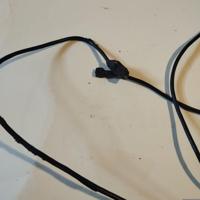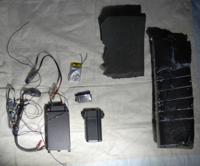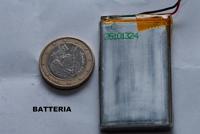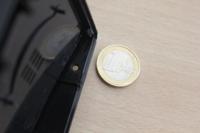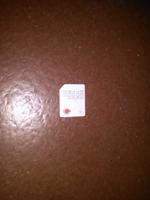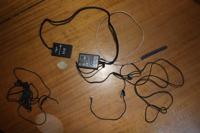A surveillance device was found in a car. It was located on the driver's side, at the bottom left, next to the seat. It was equipped with a SIM card, a 32 GB memory card, a GPS module and two microphones, one under the driver's seat and one near the seat belt, both on the same side. It was powered by cables located under the steering wheel.
Two surveillance devices were found in a car. They were located under the car upholstery. They were equipped with microphones, a GPS tracker, and a SIM card. They were connected to the car battery with a cable.
A microphone was found in a house. The device was connected to the fridge electrical outlet. It included a microphone, two antennas and a SIM card.
A listening device was found in a flat. Is was located inside a lamp. It was equipped with a SIM card and a battery.
A microphone was found in a house.
A microphone was found in a car. It was hidden inside the vehicle. The night before the device was found, one of the car's windows was broken, a few things inside it were stolen, and four men were seen tampering with the vehicle — the theft was presumably a cover-up for the device installation.
A GPS tracker and a microphone were found in a car. The device was attached with strong magnets. It contained a SIM card.

A camera and a microphone were found on a bike. They were hidden under the bike seat, inside a container resembling a tool kit. The device consisted of a main unit connected to a camera, a microphone, a battery (Li-ion, 3.7 V, 60 Wh, 16.0 Ah), a modem (EM7565 Sierra Wireless), a SIM card, a GSM antenna and a 4G antenna (Antenova SR4L002). The camera pointed outwards through a very small hole and was directed at the entrance of the building under surveillance — it was impossible to identify it with the naked eye. A few minutes after the device was spotted and removed, the suspected spies came to retrieve the bike.
A microphone was found in an apartment. It was hidden on the back of the kitchen oven. It was powered by the oven electrical supply, and was also equipped with a battery.
A microphone was found in a building. It was located inside a power outlet. It was equipped with a microphone, two antennas, a SIM card, a memory card and a battery.
An audio surveillance device was found in an anarchist library. The device was hidden inside the printer-copier of the library. It included two microphones, an antenna, a transformer, a battery, a small box containing an electronic card, a 64 GB SD card, and a SIM card. According to the article that reported the discovery of the device, it was a surveillance device of model RB800 marketed by the Italian company Innova.
Analysis of the SD card revealed that:
- The device was equipped with a “voice activation” function, i.e. it only activated when its microphone picked up a sufficiently high sound level. In the month and a half prior to its discovery, it was activated 2,061 times, with a minimum activation duration of 58 seconds, a maximum duration of 12 hours and an average duration of 10 minutes.
- When the device was “activated” by the sound level, it transmitted data over the mobile phone network (presumably the audio data captured by its microphone), generally at a rate of a few KB/s, with peaks of 100 KB/s.
- The temperature of the device varied between 14°C and 50°C, with an average of 22°C. Its temperature rose sharply when it was transmitting data.
- RB800-en.pdf: product description of the RB800 device (in English).
- RB800-fr.pdf: product description of the RB800 device (in French).






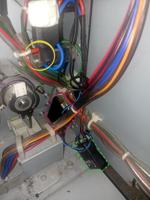



A GPS tracker and an audio recording device were found in a car. They were located behind a panel of the front ceiling light. They were connected by a power cable and drew their power from the supply line to the rear ceiling light. The GPS tracker contained, among other things, a GPS receiver “u-blox MAX-M8”, a card slot with a 16 GB microSD card, a cellular chip “u-blox LISA-U230” along with a SIM card, as well as a removable three-pin antenna module. The audio recording device contained a voltage converter, a 3.7 V, 550 mAh lithium-ion battery, and a small circuit board which included a 32 GB microSD card and the “NN01-104” antenna from the company Ignion (formerly “Fractus”). The audio recording device tapped into the microphone of the hands-free system, which was located behind a cover above the rearview mirror.
A tracking device and two microphones were found in a car. The tracking device was connected to the power supply of the control unit underneath the steering wheel on the left side. It was attached with a magnet, tape, and insulating fabric. The microphones were located at the end of a long cable running from the inside of the internal side pillar linings of the windscreen to the underside of the roof of the car. The tracking device used the GLONASS positioning system, and consisted of an antenna connected to a multi-frequency receiver box containing a micro SIM card.
A listening device was found outside. It was disguised as a rock. It contained two microphones.
A surveillance device was found inside the smartphone of the campaign manager of a Russian anti-corruption activist. It included a SIM card, a microphone, a GPS tracker, and a microcircuit to amplify the radio signal. Some of the phone components were modified to make room for the surveillance device. The device was installed when the owner of the phone was in custody and her phone confiscated. The device was probably installed by the FSB (“Federal security service”).
A GPS tracker and a microphone were found in a car. The two devices were installed separately, each in one of the front seat headrests. The headrests were opened and glued back together after the devices were installed. Each device was equipped with two batteries. The first device, which was apparently the control unit, was equipped with a GSM module to send GPS data and recorded audio files via the mobile phone network. On the control unit were a GPS/GSM antenna, the connection to the batteries and a microphone. Inside the device, a SIM card was found. The second device seemed to be the actual audio monitoring device. It also had a battery connection, a smaller antenna and two microphones, which had been glued into the holes for the seat support, with anti-vibration padding. This device was equipped with an SD card, but there were no more audio files stored in it. The SD card was apparently used as a storage medium for the operating system data and for temporary storage of the recorded data. According to what was known at the time of discovery, the GPS tracker was installed in August 2019 and the listening device in or after September 2019. The devices were presumably installed by the BKA (Bundeskriminalamt, Federal Criminal Police Office).










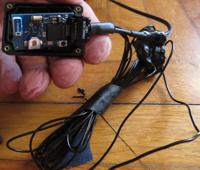




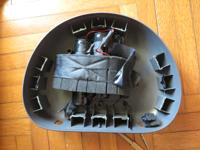
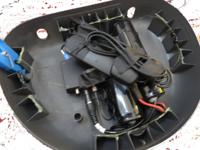



Four microphones were found in a house. There was one in each room of the house. They were connected to the electrical system of the house using a transformer and a battery. Each device was equipped with a SIM card and a memory card.
According to the source that reported the discovery of the microphones, they were supplied by the Italian company Lutech.
Microphones were found in a building. They were connected to the electrical system of the building.
According to the article that reported the discovery of the microphones, they were supplied by the Italian company Lutech.
A microphone and two GPS trackers were found in a vehicle. A first tracker was attached with a magnet to the rear bumper, on the right side. The other tracker, along with the microphone, was located in the air vents located between the windscreen flap and the windscreen. The first tracker included a SIM card and an accumulator made of five 3.6 V lithium batteries connected in a series. The other tracker was equipped with a SIM card.
A surveillance device capable of recording images and sound was found during a gathering in front of a jail. It was located behind a few stones, in a wall along a path, wrapped in a black garbage bag. It was not the first time that a gathering took place there. The device contained a battery, a SD card, a microphone, and a camera hidden behind a rock in which a hole had been made. It seemed that the device couldn't send the recorded data, which was stored on the SD card. An analysis of the content of the SD card showed that the device was activated on June 3 and was installed on the afternoon of June 7, the day before the gathering.
The pictures of the device show that the device included a digital video recorder of model “DK-PV500E”, marketed by the Italian company DSE (Digital Surveillance Equipment). This suggests that the device was supplied by the Italian company DSE.
A GPS tracker and a listening device were found in the car of an Irish republican. They were hidden in the undercarriage of the car. Shortly after the discovery of the device, the car owner's home was raided by the Special Detective Unit (SDU), and the car was seized.
Microphones were found in a building. They were located in the kitchen.
Six microphones and a camera were found in a house. The microphones were located in electrical outlets and switch cases, one above the intercom in the corridor, two other in the living-room, and the three last ones in bedrooms. The camera was located inside the intercom in the corridor and connected to the microphone above it. Each microphone was equipped with a battery, and, except for the one in the corridor, with a SIM card and a memory card. The camera lens could observe through a small hole already present in the intercom structure and slightly modified to fit the device.
A microphone was found in a car. It was located in the upholstery of the vehicle roof. The device wires were hidden in the isolation case. The device was connected to the car electrical system, so that it turned on when the car started. It included a SIM card.
Two microphones and a GPS tracker were found in a car. The microphones were located above the driver's head, next to the junction of the car roof upholstery and the windscreen. The GPS tracker was located in the fuse box. Everything was powered by a connection to the headlights cable. The headlights were dysfunctional, seemingly because of the power supply required by the devices.
Two microphones and a GPS tracker were found in a car. The microphones were located inside the upholstery of the car roof, just above the driver's head. The GPS tracker was attached to the car body with a magnet. The devices were connected to the car power supply at the level of the pedals, just below the lever that opens the front trunk.
Three outdoor surveillance cameras were found outside, close to the venue of an event. They were located along a 250m pathway leading to the venue. Among them, two cameras of model “BOLYGUARD MG983G” were found laying in the grass and in a bush, 80 centimeters above ground and were covered by a kind of camouflage hairnet. The third camera, of model “RECONYX HYPERFIRE SM750”, was found on a tree trunk, 1m20 above ground and had a khaki color.
The contents of the SD cards revealed that:
- The cameras were installed on the day they were found, very early in the morning (between 3h30 and 4h)
- They were capable of night vision. Two of them were configured to take pictures and the third one to record video and sound.
- Their positioning allowed them to take pictures of the front and back license plates of cars driving on the pathway, and of people walking on the pathway.
- One of the cameras was useless because of leaves in its field of vision.
The cameras were marketed by the companies RECONYX and Boly.
- BOLYGUARD-MG983G-en.pdf: user manual of the "BOLYGUARD MG983G" camera (in English).
- BOLYGUARD-MG983G-fr.pdf: user manual of the "BOLYGUARD MG983G" camera (in French).
- RECONYX-HYPERFIRE-en.pdf: user manual of the "RECONYX HYPERFIRE" camera (in English).
A microphone was found in a building. It was located in a multi-socket adapter. The device contained a printed circuit board and a battery. It was seemingly installed during a house search by police earlier in the month.
Two microphones were found in a house.
Several surveillance devices were installed from 2015 to April 2018 in the Ecuadorian embassy in London to surveil Julian Assange, founder of the news organization Wikileaks, which had taken refuge in the embassy since 2012. During this period of time:
- The interior cameras were replaced with higher resolution cameras equipped with hidden microphones.
- Microphones were hidden inside a fire extinguisher and above the storage cabinet in the bathroom used by Assange.
- Special stickers were attached on the exterior windows of the embassy to facilitate the use of a laser microphone (able to capture audio by detecting the sound vibrations in the windows) from a building nearby.
- A device capable of transmitting in real-time the information collected by the other devices was installed.
The microphone inside the fire extinguisher was equipped with an SD card and a battery which was changed every twelve hours. The microphone in the bathroom was connected to the electrical system of the building. The devices were installed by the Spanish company Undercover Global, officially in charge of the security at the embassy. Their installation appeared to have been ordered by the CIA (Central Intelligence Agency).


Two microphones and a GPS tracker were found in a car. The device was attached to the car body with magnets and connected to a cable carrying power to one of the lights inside the car. The microphones were attached with gum over the driver's and passenger's head seats. There was also a battery. The power cable, battery, microphones and GPS were all connected to a transmitter. There was a SIM card inside the transmitter.
A listening device was found in the former home of an Irish republican, who had died ten years prior to the discovery of the device. It consisted of a small microphone, hidden in the ceiling of a downstairs room, along with a number of battery packs located under the floorboards of an upstairs bedroom.
Two microphones were found in a building. They were hidden inside a power outlet and in the junction box next to it.
Two microphones and a GPS tracker were found in a car. There was also a device equipped with an antenna, a SIM card and a 16 GB memory card. The microphones were located under the upholstery of the car roof and the wires reached the power supply through the car door. The power cable was connected to the fuse box and to other wires located under the dashboard. The magnetized GPS and a thing with an antenna and cards were hidden behind the speedometer. Everything had been seemingly installed in the car more than a year before the discovery and the microphones were recording even when the car engine was turned off, in a radius of several meters.









Microphones and a GPS tracker were found in a car. They were located in the fuse box. The car had been having electrical problems (the battery had discharged twice in a month, sign of an abnormal electricity consumption), presumably because of the devices.
Microphones and GPS trackers were found in two cars.
Microphones and GPS trackers were found in a car. The microphones were located under the upholstery of the car roof, where the windscreen and the sun shields are. In one case the power cables reached beneath the wheel, in the other they were attached to the car lights.
A surveillance device was found in a building inside an outlet not connected to any electrical network. The acronym “ABG” was visible on one of its edges.
A microphone was found in a building. It was located inside a neon light attached to the ceiling. It consisted in three 9-volts batteries, joined together with insulating tape, with a microphone and antenna at each end.
Listening devices were found in a building. They were hidden in electric sockets.
A listening device was found in the home of an Irish republican. It was built into a joist in a space between a ceiling and a bedroom floor. It contained several small listening devices that were connected to spotlights.
Two microphones were found in a home. The devices were inside two electrical outlets. Each consisted in a microphone connected to a transformer, and a thing containing a micro-SIM card.
A listening device and a tracking device were found on the car of an Irish republican. The listening device was attached to a rear wheel arch of the car by several powerful magnets. The tracking device was located under the opposite wheel arch. The listening device was powered by 12 long-life batteries. The tracking device also appeared to be battery-powered.
Three microphones with cameras were found in the alleys around a building. The devices were pointed at the different entries of the building.
The pictures of the devices show that the cameras were marketed by the Italian company Elkron (which became a subsidiary of the Italian company Urmet in 2012). This suggests that the cameras were supplied by the italian company Elkron.
A GPS tracker and a listening device were found on the car of an Irish republican. Parts of the device — battery packs and a transmitter — were hidden behind the car rear bumper.
Two microphones and portable scanners were found in a building and outside of it. The portable scanners were in a telecom booth close to the building. The microphones were connected to the electrical network of the building.
Two bluetooth listening devices and a tracking device were found in the car of an Irish republican. The devices were hidden on the underside of the driver's seat, underneath carpet in the rear passenger footwell, and behind the rear seats.
Microphones were found in a building.
Four microphones were found in two homes. In the first home, a microphone was located next to the office where there was a computer (for some time, the loudspeakers connected to this computer were disrupted by an interference similar to the interference of a phone receiving a call), another in the outlet next to the kitchen table, and the last one in the bedroom, in the outlet closest to the bed (the outlet cover had been pierced to direct the microphone towards the headboard). In the second home, a microphone was located in the bedroom, in the outlet closest to the door leading to the kitchen, so that it covered several rooms. The first home's microphones included a transformer and antennas with a printed circuit board. The second home's microphone included two transformers and an antenna.
Two microphones and a GPS tracker were found in a car. They were located in the car ceiling. The device included SIM cards, a transformer, and antennas with a printed circuit board. The microphones were pointed towards the front seats.
Two microphones were found in a building. They were located in the air vents of two rooms of the building. Each consisted in three 9-volt batteries set up in parallel, attached with tape to a transmitter microphone.


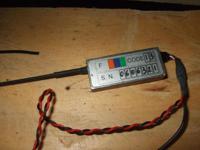
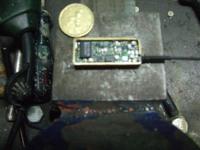

A listening and geolocation device was found on a scooter. It was located in the spare wheel bracket, next to the tank and behind the horn grid. It was based on a device sold by Telit (an Italian supplier of wireless technologies). The device model was “Telit GM862-GPS”. It was capable of listening with a microphone, geolocating with a GPS antenna, and transmitting the collected information on the mobile phone network with a GSM antenna. The device was located in the spot where the tank is along with a transformer and an accumulator. Both antennas (GPS and GSM) were connected to the device and ended up in the spare wheel bracket. The microphone, also connected to the device, ended up behind the horn grid. Wires connected the device to the scooter starting system. All these components were attached to the scooter frame by strong magnets secured by tape. This scooter model doesn't have a battery (it dates back to the 1980s) and its engine generates alternating current, hence the presence of a transformer and an accumulator to power the device even when the scooter was not moving.
- Telit-GM862.pdf: product description of the Telit GM862-GPS device (in English).
Four microphones and a camera were found in a house. A microphone was located behind the fridge, another in the bedroom, another in a beam next to the ceiling light, another in the house entry. A small camera filmed the entry stairs. All were connected through a transformer to the house electrical network.
Microphones and cameras were found in a building. A first device was located in an electrical case that was abnormally hot. It consisted of a microphone and a micro-camera. A second device was located in an industrial outlet.
A microphone was found in a building. It was located inside a closed and sealed electricity meter. It was a microphone with a 300 MHz shortwave transmitter.
Microphones and a micro-camera were found in multiple homes. The devices were found in an amplifier, in the kitchen hood and in a cathode-ray television. They included microphones and 300 MHz transmitters with ranges of 200 to 300 meters. One of the devices could be activated by remote control (at a distance of hundreds of meters). Another device came with a micro-camera linked to a UHF band transmitter.
A microphone was found in a building. It was located inside an electrical outlet. It was a transmitter-receiver.
A GPS tracker and a microphone were found in a car. The device was located between the car body and the interior coating, attached with two magnets. It was connected to the car power supply by the car interior light wires. It consisted in a modified mobile phone, an antenna, a GPS and a microphone.
A microphone was found in a building. It was located inside an electrical outlet.
A GPS tracker and microphones were found in a car. The device was located in a plastic container (badly) sticked under the roof. It contained two boxes, both of which included a SIM card. From there wires went out, through a hole, up to under the back seats. There were two microphones along the seat belt canal: the first at the driver's height, the second at the height of the levers used to adjust the seat, next to the back seats. The antenna was behind the back seat. Finally, still coming from these two boxes, a wire went through the car doors to reach the car fuse box.
A GPS tracker and a listening device were found under the car of someone linked to Irish republicans. Parts of the devices were located under the car bumper. The listening device used a microphone to transmit conversations within the vehicle over the mobile phone network.
A microphone was found in a home. It was hidden inside an air inlet. It consisted in 12 cylindrical batteries and a microphone.
A listening device was found in an apartment. It was located under the sofa. It was made of two meters of wiring with a microphone at the end. It was installed from the apartment below, through a hole in the floor.
Two receiver cases were found in the entry corridor of a building. They were hidden above a fake ceiling in the entry corridor. They were connected to the phone line with telephone wires. They consisted in a main unit with a remote-controlled connector, a digital receiver showing the strength of the received signal, and antennas. The presence of the two receivers presumably meant that there were two emitting microphones in the building.
Microphones were found in a car. The device was located in the car ceiling. It was connected to the car interior light power supply. It consisted in a modified mobile phone, an antenna and two microphones.
A listening device was found in the home of an Irish republican. It was located in a cavity of the kitchen ceiling.
A surveillance device was found in the roof of a car. It was equipped with a microphone. It seemed that the device was causing interference that could be heard on the car radio.
A surveillance device was found in a car. It was located in the roof of the vehicle. It was equipped with one (or two) microphone(s). It was powered by sunlight. It seemed that the device was causing interference that could be heard on the car radio.
A listening device was found in offices used by Irish republicans. The device, disguised as a floor joist, was hidden under the floor of a first floor office with microphones pointing into the office and into a conference room below. It included a large battery pack.
A listening and tracking surveillance device was found in a car used by Irish republicans. It was built into the car body in such a way as to make it impossible for anyone carrying out repairs on the vehicle to find it. It was able to track the location of the vehicle, record and transmit audio, and could be switched on and off remotely. It included a microphone built into the middle of the roof of the vehicle, as well as rechargeable batteries wired to the car that could recharge only when the car was running.

 English
English




